How to create, host & manage a Docker network
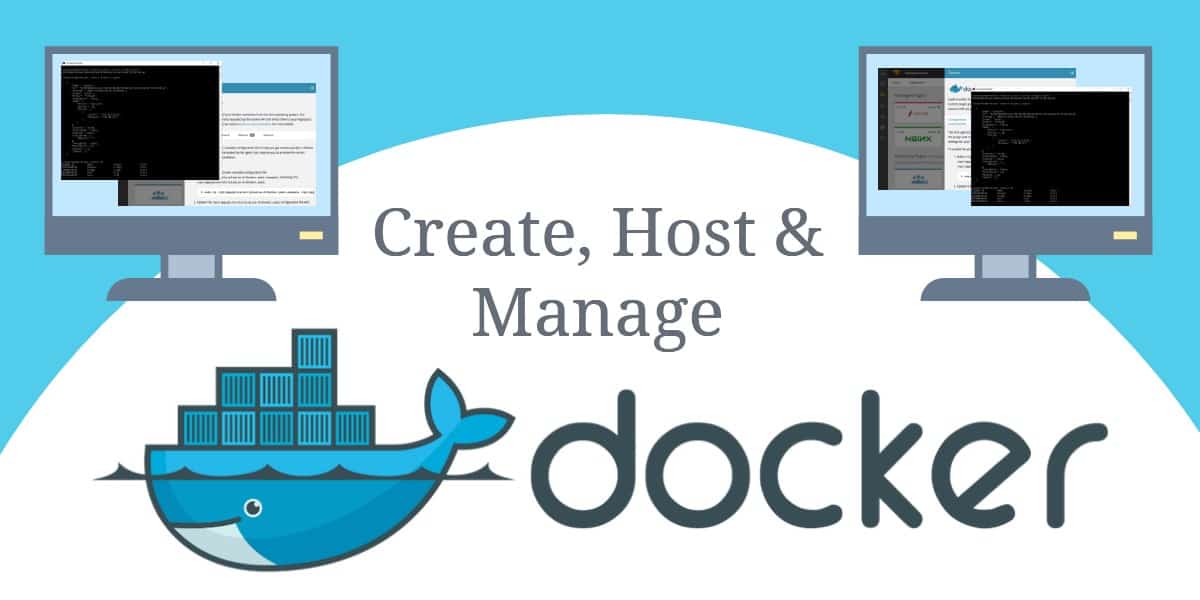
Docker uses a novel approach to support virtualization of application delivery. It converts the application into an image and then sends that image over the network to the user endpoint.
This packaging system is particularly useful for the delivery of software to user-owned mobile devices. The Docker technique removes the need to install software on the device and it doesn’t require the entire device to be dedicated to company business. The transmission unit for a Docker connection is called a ‘container’ and the methodology of Docker is called ‘containerization.’
We get into a lot of detail below on each of the Docker network tools we feature, but if you’re short of time, here is our list of the five best Docker network monitoring tools:
- SolarWinds Docker Monitoring with AppOptics
EDITOR’S CHOICE
This package runs in the cloud and can track all network elements and applications on site and in the cloud. Docker is offered on many platforms and this system follows them all. Access a 14-day free trial. - Datadog Docker Monitoring
(FREE TRIAL)
Online network monitoring platform, which can be enhanced by a plug-in to monitor Docker activity. - Paessler Docker Monitoring with PRTG
(FREE TRIAL)
A three in one network, server, and application monitoring package that includes special modules for Docker tracking. - Portainer Especially designed to add management functions to Docker, this tool is free to use and runs on any operating system.
- cAdvisor Free tool provided by Google to monitor Docker activity. It is browser-based, and so operating system-neutral.
The container-based solution of Docker has many advantages over standard virtualization. The container supports a neutral operating system, which is provided by Docker. This means that the delivery of software to remote devices is operating system-neutral.
Docker is an open-source project, which means that it is free to use. Other software producers are able to integrate Docker capabilities at no cost. For example, Docker capabilities have been integrated into Windows Server since Windows Server 2016.
Implementing Docker is relatively simple. However, the types of applications that you want to deliver with the system will greatly influence the architecture that you employ for containerization. In this guide, you will learn about your options and how to exploit the Docker system to connect your end-user devices to application servers.
Installing Docker
The software for Docker is available for free on the GitHub website. This is called the Community Edition because the people who created Docker also run a business for a paid version of the system. Docker software installs on Linux, Mac OS, and Windows. Docker Inc also offers a Software-as-a-Service (SaaS) version of the system, which you can access online.
The base application is called Docker Engine and you can download it for CentOS, Fedora, Ubuntu, and Debian Linux, and it is also available in versions for Mac OS and Windows. You can also get Docker Engine to run on the AWS and Azure Cloud platforms.
Docker implementation has two parts. These are a daemon that runs on the software server called dockerd and a client program called Docker.
You need to have Microsoft Hyper-V in order to run Docker on Windows. If you have Windows 10, Windows Server 2016, or Windows Server 2019, you already have Windows Containers on your computer. This includes a Hyper-V Isolation option, which is required for Docker.
The installation process for Docker on Windows will turn on the Hyper-V utilities resident in the operating system.
If you want to install Docker for Mac for free, your computer must have been manufactured in 2010 or later and needs to be running macOS El Capitan 10.11 or higher.
If you have Windows 7, Windows 8, or an older Mac, you need to install Docker Toolbox instead of Docker for Windows or Docker for Mac. This download will install the required Hyper-V elements for you.
Docker options
Docker was written for Linux. So, the standard operating system built into a Docker container is based on Linux. If you run Docker on Windows, you have the choice of building containers with Linux inside or Windows. When you choose one or the other operating systems, you can still switch to the other operating system and leave existing containers running.
You can only issue management commands for containers created with the operating system that you currently have active. It IS possible to have both Windows and Linux containers running simultaneously. However, you will have to keep switching from one system to the other in order to monitor each type.
Related post: Docker vs Virtual Machines
Running Docker
Docker doesn’t have a GUI interface. It is a command-line system. So, if you are in a GUI environment, such as Ubuntu, Mac, or Windows Desktop, you will have to open a terminal session in order to access the system. You can operate Docker commands on a remote computer through an SSH session.
The format for running Docker is:
Docker [OPTIONS] COMMANDYou can get a list of the options and commands for Docker by just typing in Docker.
Docker includes a help system, and you can access it by typing:
Docker <COMMAND> --helpDocker network details
Docker uses five network drivers. These are bridge, host, overlay, macvlan, and none. The meanings of the five driver types are:
Mục Lục
Bridge network
Bridge is the default network driver. Use this network type to enable applications in standalone containers to communicate. The containers would be limited to communicating through the same host.
Host network
Host networks operate on the Docker host’s network. This scenario is possible if the client is able to connect to the same LAN as the host. This network type is suitable for swarm services. A swarm connection involves several Docker daemons communicating with each other.
Overlay network
The overlay network caters to swarm services. This configuration connects together several Docker daemons to enable the exchange of containers. The overlay can also facilitate standalone container communication. The main difference between overlay and bridge is that the daemon on each side of the connection is active.
Macvlan network
The Macvlan network gets its name from the MSAC address, not the Apple computer. With this type of network, you can give containers MAC addresses so that they appear on your network as though they were physical devices. Communication across the internet is still conducted by IP address. However, once the containers arrive on the local network, the Docker daemon routes them through switches. This option is suitable for applications that don’t allow you to route through the Docker server. The originator of the container is a network endpoint.
None
The none driver disables Docker networking functions but requires a specialized substitute network interface to route containers.
Docker network implementation
When you install the Docker system it will automatically create a bridge, a host, and a none network. As soon as you start up Docker, you can query the system to see those three new networks. Use the command docker network ls:

The network option of Docker includes the following options:
- Connect – Connect a container to a network
- create – Create a network
- inspect – Display detailed information on one or more networks
- ls – List networks
- prune – Remove all unused networks
- rm – Remove one or more networks
The output of the inspect option is formatted like a ‘C’ program and is difficult to read. Rather than using the ID of the network, you ask for details of the driver type. So, in order to see information about the bridge network, you would enter docker inspect bridge.
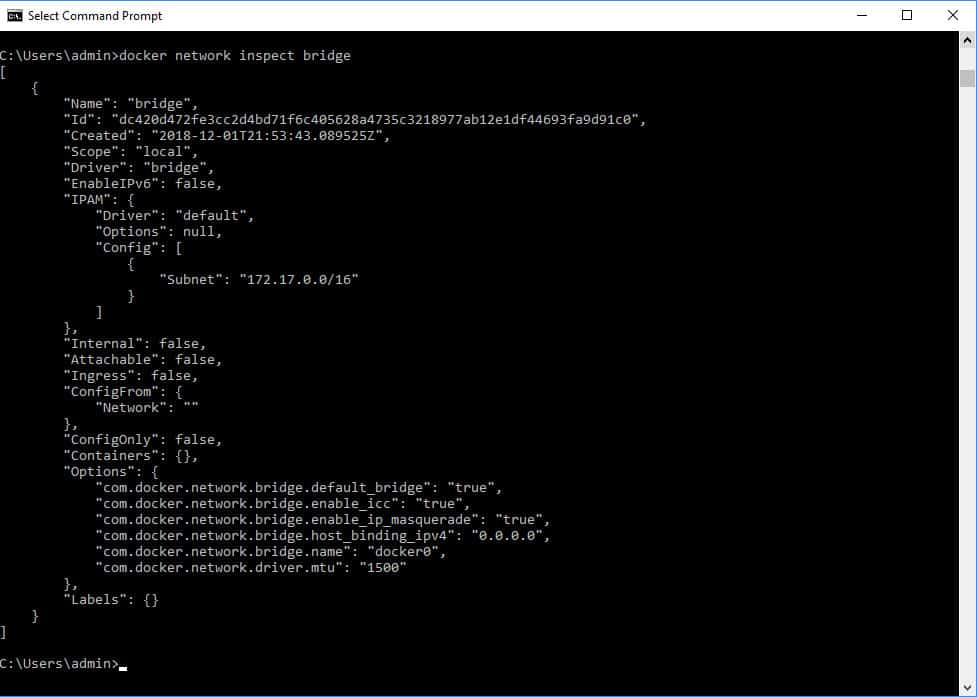
The output from this command is not very well presented and is not easy to understand. You can get better manageability for Docker if you use a third-party front end for the system.
How to create a Docker network
The Docker network create command will set up a new network. This command has a number of options:
–attachableEnable manual container attachment
–aux-address map Auxiliary IPv4 or IPv6 addresses used by Network driver (default map[])
–config-from string The network from which copying the configuration
–config-onlyCreate a configuration only network
-d Driver to manage the Network (default “bridge”)
–driver stringAs above
–gateway stringsIPv4 or IPv6 Gateway for the master subnet
–ingressCreate swarm routing-mesh network
–internalRestrict external access to the network
–ip-range stringsAllocate container ip from a sub-range
–ipam-driver stringIP Address Management Driver (default “default”)
–ipam-opt mapSet IPAM driver specific options (default map[])
–ipv6Enable IPv6 networking
–label listSet metadata on a network
-oSet driver specific options (default map[])
–opt mapAs above
–scope stringControl the network’s scope
–subnet stringsSubnet in CIDR format that represents a network segment
The most common type of network that you will create uses the bridge driver.
Create a bridge network
As you can see from the options for the create command, it is relatively straightforward to set up a bridge:
docker network create --driver bridge StephenThe last string in the command is the name of the network. I named my network after myself. You could choose your own business-related name. After creating the network, you will see a string of characters shown on the screen. This is the new network’s ID. However, you don’t need to remember that ID because you can refer to the network by its name, as shown in the inspect command output below.
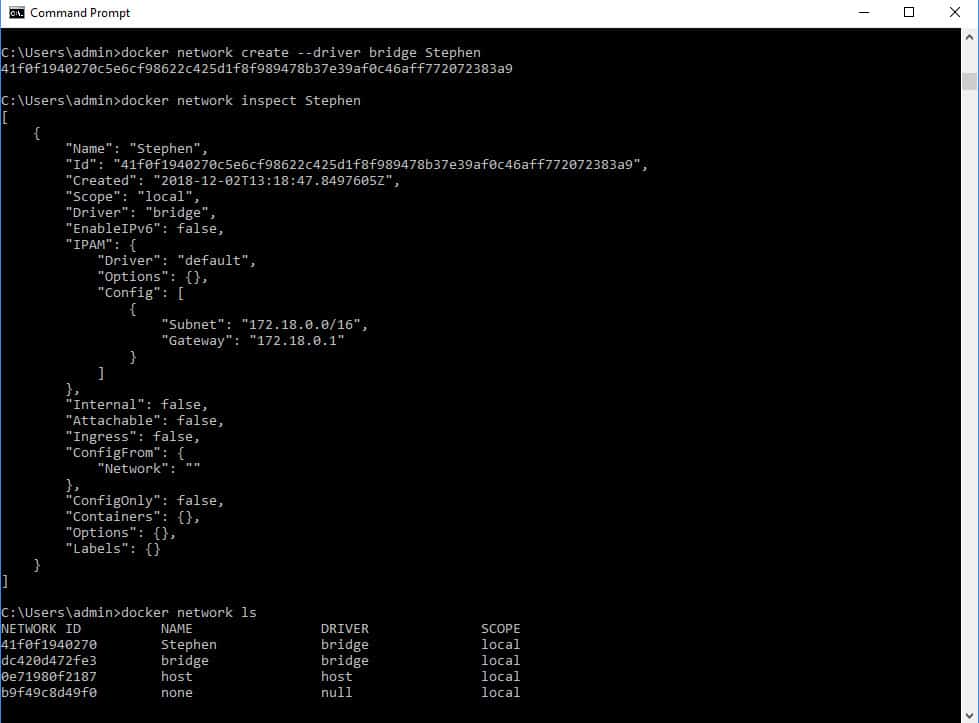
The list of current networks shows that the new network did not replace the original default bridge network.
Unfortunately, it isn’t possible to change the attributes of a network once it has been created. If you want to update features, you will have to delete the network and then remake it with the desired attributes.
Use the rm option on the network command to delete a network:
docker network rm StephenDon’t forget to include the network name in the remove command. Check the list of networks to confirm that the network has been deleted.

Once a network no longer exists, you can create it again with new attributes.
Create an overlay network
The overlay network is more complicated to set up than the other network types. In this scenario, you need to get the Docker daemon on your computer communicating with Docker daemons on other computers – one or more other computers.
The connection between daemons is called a swarm. These are created and managed by the docker swarm command. The swarm commands are:
- ca – Display and rotate the root CA
- init – Initialize a swarm
- join – Join a swarm as a node and/or manager
- join-token – Manage join tokens
- leave – Leave the swarm
- unlock – Unlock swarm
- unlock-key – Manage the unlock key
- update – Update the swarm
One of the computers in the group needs to be designated as a swarm manager. The command to create this status is slightly different on Docker for Windows and Docker for Mac as it is for the Linux and Docker Toolbox implementations.
On Docker for Windows and Docker for Mac, enter this command:
docker swarm initOn all other Docker types you need to get the host computer’s IP address and add this to the command:
docker swarm init --advertise-addr <IP address>That sets up a swarm. Read the feedback message that comes back from the successful execution of the command. This gives you the swarm ID and the IP address of the manager.
You can then add other nodes to the swarm, which can either be managers or a worker. You don’t need to issue any more swarm commands on the computer that you ran the init command on.
To join the swarm on the computer where you ran the init command, just enter:
docker swarm join --token <Swarm ID> <Manager IP address>The token needed to add another manager to this swarm is different than the token given for workers. To get the manager token, run the following command on the computer that you ran the init command on:
docker swarm join-token managerIf you lose the worker token, you can get it revealed to you again with the command:
docker swarm join-token workerYou can see details of the swarm and its manager by issuing the command:
docker node lsCreating the swarm adds two new networks to your host. These are called docker_gwbridge, which is a bridge network and ingress, which is an overlay network. To create your own overlay network, issue the network create command, giving it a name for the new network:
docker network create --driver overlay StephenThe results of this command can be seen below:

Note that the scope of the new overlay network and the ingress network is swarm.
Create a macvlan network
The procedure for creating a macvlan network is the same as that for a bridge network. You just need to specify overlay as the driver:
docker network create --driver macvlan StephenCreate a host or a null network
Both the host and null networks get set up when you start Docker. These two networks cannot be removed. You can only have one instance of each of these network types. Therefore, it isn’t possible to create your own host or null networks.
Attach a container to a network
Now you have your network set up, you can use it to carry containers.
Once you have created an image for your application, you can put that in a container and send it on a chosen network. In the following command, appim is the image that you want to send and docker-appim is the name that you are giving to the container that this command will create. In the example below, Stephen is the name of the pre-existing network.
docker run --network=Stephen -itd --name=docker-appim appimManaging a Docker network
There are a lot of Docker commands, all of which need to be issued at the command line. The lack of ongoing reporting is a big weakness of Docker. In order to monitor the performance and throughput of a Docker network, you have to constantly issue commands to provoke feedback.
The best monitoring utility you get with Docker is the docker stats command. This shows a live list of Docker container activity. Unfortunately, this utility ties up the terminal. You have to press Control-C to get out of the tool.
As a systems administrator you will probably feel uncomfortable about the lack of visibility that Docker gives you.
You don’t want to have to go back to the days when the only way you knew that something was going wrong with the network was when users rang up to complain. Fortunately, there are third-party tools that will monitor activity on your Docker networks and keep an eye on system health so you can head off failure. There are many tools available on the market for network monitoring, but not all of them cover Docker networks effectively. This guide includes recommendations on the software that you could install in order to monitor Docker activity.
Our methodology for selecting Docker network monitoring and management tools
We reviewed the market for Docker monitoring and management systems and analyzed the options based on the following criteria:
- A system that can follow Docker container instance creation
- A method to track Docker memory management
- A system that can note Docker activity and intersections with other packages and users
- Monitoring of Docker container resource usage
- A method to identify the activities of the different components within the container
- A free trial or a demo package for a no-cost assessment opportunity
- Value for money from a monitoring tool that can also monitor servers and networks to provide systemwide supervision
You can read more about each of these options in the following sections.
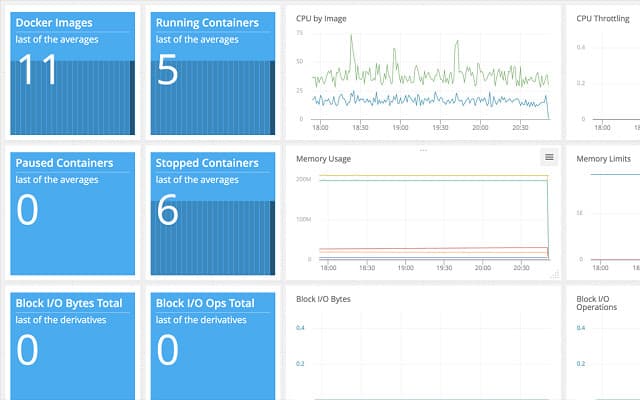
AppOptics is a Cloud-based system monitoring tool from SolarWinds. This utility will monitor servers and networks that are both on-premises and in the Cloud. The tool requires data collectors to be active on a host on the network. These collectors can run on Windows and Linux, as well as Cloud platforms, such as AWS.
Key Features:
- Easy to set up
- Application dependency mapping
- Server resource monitoring
- Docker activity monitoring
- Network monitoring
The price model of AppOptics works well for Docker implementations. The system is charged per host, so if you have one application server and want to deliver all of your containerized software from that, you only need to watch the traffic from one source. The number of Docker virtual networks doesn’t influence the price of AppOptics.
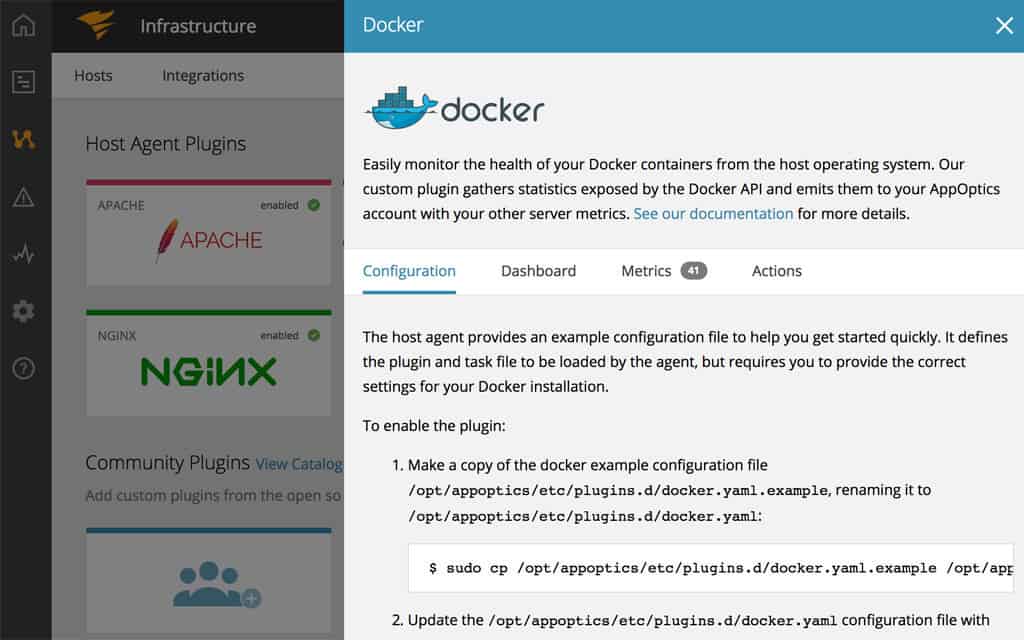
AppOptics has two price levels. The cheaper plan just monitors infrastructure, which means the server and network delivery systems. This plan also includes container monitoring, so if you just want to check on the performance of Docker, then this option will be good enough. The higher plan also includes container monitoring and adds on application performance monitoring.
Pros:
- Offers great visualizations reflecting live and historical health metrics and resource consumption
- Is easily scalable, built as a cloud service
- Tracks all major resources metrics (great for beginners and veterans)
- Can monitor Docker, Azure, and Hyper-V platforms, offering more flexibility than competing options
Cons:
- Would like to see a longer trial period
AppOptics gives you a web-based dashboard, so you can access it from anywhere, even when you are out of the office. The charging rate for the service is billed on a subscription basis. You can pay for it per month, but you get a better rate if you sign up for an annual subscription. You can sign up for a 14-day free trial to evaluate the tool.
EDITOR’S CHOICE
AppOptics is our top pick for a Docker monitoring and management tool because it covers a wide range of technologies, not just Docker. However, the Docker monitoring functions of this package is just one part of the AppOptics service. This package can map all applications and the services and services on which they rely for resources. It can also examine the activities within each container. The service will raise an alert if there are signs of problems with your containers, which is usually due to a shortage of supporting resources. The servers that support your Docker containers will simultaneously be providing memory space and CPU time to other applications. So, the package might alert on several applications at the same time. When you get notifications of Docker problems, you will quickly be able to find out the cause of the problem because your AppOptics monitor will also be watching over server and network performance.
Download: Get a 14-day free trial
Official Site: https://my.appoptics.com/sign_up
OS: Cloud based
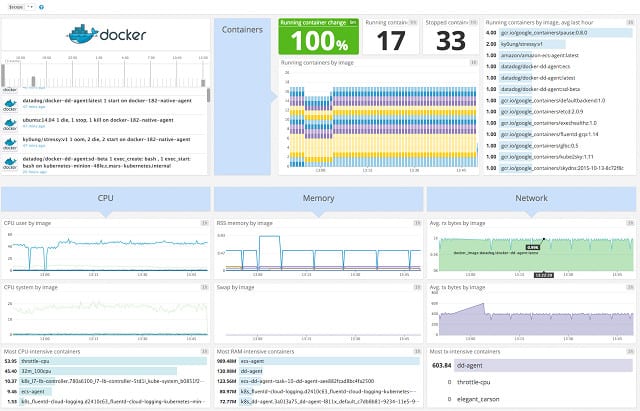
Datadog is delivered through a Software-as-a-Service format. This is a general network and server monitoring tool that can be enhanced by adding on an agent for Docker, which is available for free from the Docker Hub.
Key Features:
- Container discovery
- Simultaneously monitors all containers
- Scans every 15 seconds
- Stores metrics for analysis
Datadog is primarily an application performance monitor. It also examines log files to identify system problems that could impact software delivery. The tool is able to monitor the performance of Cloud-based services as well as on premises servers and applications.
The dashboard includes a group chat function that enables a team to communicate and share tasks to resolve performance issues. Team members can share snapshot views of dashboard performance graphs and schedule tasks.
Datadog also includes analysis functions that work on stored data. This source data usually comes from system logs, but you can also save your own data selections for historical analysis.
The Docker monitor in the Datadog system tracks container traffic events and shows a live event message board on the dashboard. The tool also presents live data on transfer events, application performance, and server load. The dashboard screen for Docker monitoring includes some great graphical representations to make performance data easy to interpret.
Pros:
- Easy to use customizable dashboards
- Cloud-based SaaS product allows monitoring with no server deployments or onboarding costs
- Can monitor both internally and externally giving network admins a holistic view of network performance and accessibility
- Supports auto-discovery that builds network topology maps on the fly
- Offers flexible docker environment monitoring through plug-and-play add-ons
- Great pricing options, accessible for both small and large businesses
Cons:
- Would like to see a longer 30-day trial
This is a paid tool, but you can get a 14-day free trial to put it through its paces.
Datadog Docker Monitoring
Start 14-day FREE Trial
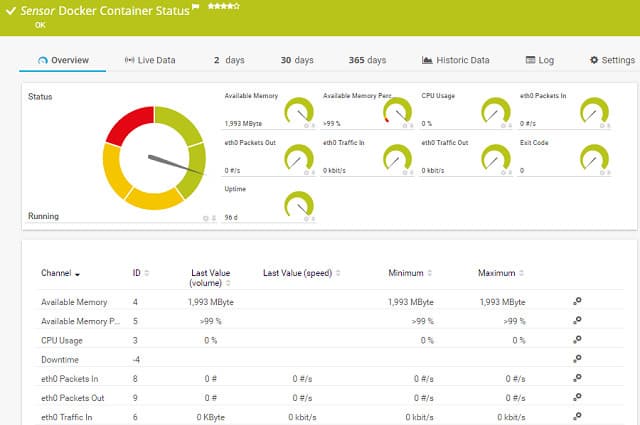
Paessler PRTG is a unified infrastructure monitoring system. It covers networks, servers, and applications. It will also monitor your Docker container traffic. PRTG is composed of services that are called sensors. A sensor monitors one type of activity, such as CPU usage on a server, or data throughput on a network. The package includes sensors that are specifically aimed at monitoring containers.
Key Features:
- Watches Docker network activity
- Track creation and destruction
- Root cause analysis
The Docker Container Status Sensor will add visibility to your Docker network activity. The live monitoring data given by this sensor can be added to the other network traffic sensors in PRTG to give you a full network status report. Containers might be experiencing delivery problems that are caused by overloading on the network, or under-performing, or damaged network equipment. PRTG lets you see exactly what part of your system is causing problems.
Pros:
- Uses flexible sensors to monitor different aspects of your webpage and webserver resources
- You can use up to 100 sensors free
- Great option for businesses looking to monitor docker as well as other environments and infrastructure
- Pricing is based per sensor and allows both large and small businesses to scale within the PRTG ecosystem
Cons:
- Feature-rich, and takes time to learn all of the features and functionality the platform offers
Paessler charges for its service in bands of sensor quantities. Every customer receives the full package of PRTG and tailors the pack by only activating specific sensors. If you only activate up to 100 sensors, you can use the system permanently for free. So, if you only take on PRTG for its container sensor, you won’t have to pay anything. You can download a 30-day free trial of PRTG with unlimited sensors. The software installs on Windows Server.
Paessler Docker Monitoring with PRTG
Download 30-day FREE Trial
See also: Docker Container Monitoring Tools
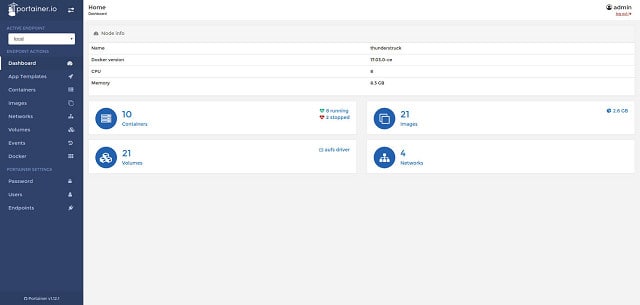
Portainer was specifically designed as a user interface for Docker. As such, it is the most perfect match that you can find to make up for the fact that Docker doesn’t have a GUI front end. This is a pure Docker management interface and it is open source and free to use. The tool covers all Docker container activity and is a great way to set up and monitor swarms, which can be difficult to keep track of.
Key Features:
- Specializes in Docker and Kubernetes
- Governance and activity logging
- Manage and monitor containers
Although it is free to use, you will have to pay for support. The company that developed this tool is called Portiner.io and it offers two levels of support in paid packages. Without that service, you will have to rely on the user community for support, which is available through a Slack channel.
Portainer runs as a Docker container, so it installs on any operating system that Docker runs on. The dashboard lets you look at every element of a Docker implementation from images through to endpoint activity.
Pros:
- Specifically designed to make Docker management easier and more scalable
- Completely free
- Offers a more visual way to manage your environment beyond the CLI
Cons:
- Unlike other tools, Portainer only monitors Docker containers
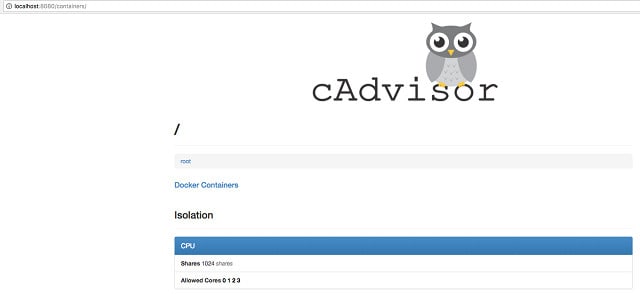
Google produces cAdvisor specifically to monitor containers. This is an open source project with its code available on GitHub. This tool was written on Linux, but it was then exported to an image, so it will run in a container. Thankfully, this monitor has a graphical user interface, which is accessed through your browser.
Key Features:
- Provided by Google
- Tracks resource usage
- Only monitors one host
The information shown in the screen is taken directly from the output of the docker stats command. However, being browser-based, you aren’t stuck in a terminal session and the font is easier on the eye than the presentation of the docker stats output.
The live data that you will see in the monitoring screen are the CPU, disk, and memory utilization on your Docker host, network interface activity on the host, and traffic volumes per network.
As a free tool, this is a great opportunity for small businesses that run Docker. However, cAdvisor is limited to monitoring just one host. So, if you have a multi-host/swarm-based implementation, you will have to look elsewhere for a Docker monitoring tool. Other problems with cAdvisor are that it isn’t able to analyze or display historical data and it doesn’t have any alerting features.
Pros:
- Free tool for monitoring Docker services and environments
- Uses a web-based dashboard for simple and easy access
- Developed and updated by Google
Cons:
- Only monitors Docker environments
- Requires more technical knowledge to set up and use
Managing Docker containers
The absence of a graphical interface for Docker makes the system harder to manage than regular virtualization systems. Adding a front end to your Docker implementation will expand your usage of this interesting method for software delivery.
Getting into Docker is becoming increasingly easier, thanks to the adoption and integration of containerization by Microsoft. The inclusion of container methods in Windows 10 and recent versions of Windows Server will make the usage of Docker much more widespread over the coming years.
The inclusion of Docker on Cloud servers also will increase the system’s proliferation. You can even get Docker itself on the Cloud, so if you want to push as much of your IT infrastructure requirements offsite, Docker has already got a solution for you.
Considering the suitability of Docker to delivering corporate apps to remote user-owned mobile devices makes this virtualization method an ideal solution for businesses that have no premises and use independent contractors instead of staff.
Remote, home-based contributors will use their own equipment and their geographical spread removes the need to rent office space, thus also removing the requirement for onsite infrastructure. Docker enables the delivery of corporate software to remote devices without the need to install the software on the worker’s own equipment. This makes the onboarding and termination of contractors a risk-free proposal.
So, Docker is the delivery system of the future. The macvlan network type is a good channel for switching over from a traditional virtualization system to Docker. The addition of a GUI front end, thanks to tool providers, such as SolarWinds and Paessler makes the move to Docker even more tempting.
Do you use Docker to deliver software and services to your network users? Did you find any problems setting up the networks? Which network driver do you use the most? Do you use a monitoring tool or do you rely on the command line system native to Docker? Leave a message in the Comments section below and share your expertise with the community.















![Toni Kroos là ai? [ sự thật về tiểu sử đầy đủ Toni Kroos ]](https://evbn.org/wp-content/uploads/New-Project-6635-1671934592.jpg)


